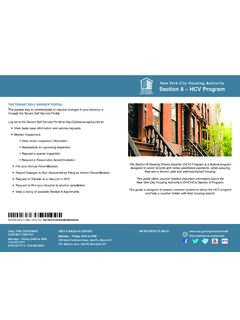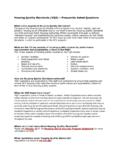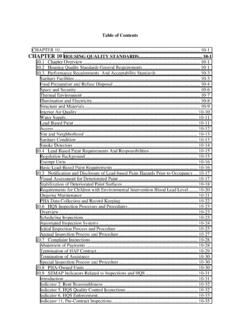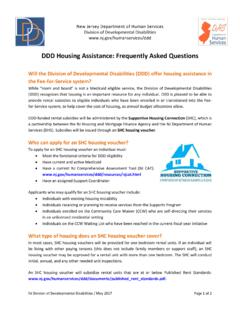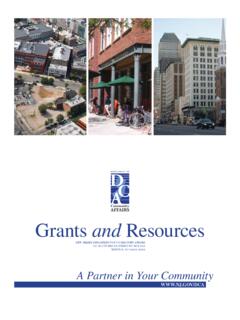Transcription of DAIN-ZA 12 January 2021 MEMORANDUM FOR SEE …
1 DEPARTMENT OF THE ARMY OFFICE OF THE DEPUTY CHIEF OF STAFF, G-9 600 ARMY PENTAGON WASHINGTON, DC 20310-0600 DAIN-ZA 12 January 2021 MEMORANDUM FOR SEE DISTRIBUTION SUBJECT: Distribution and Implementation of the Army Barracks Management Program Handbook Version 2 For applicable references, see Appendix Purpose. This MEMORANDUM provides the enclosed Army Barracks ManagementProgram (ABMP) Handbook version 2 for immediate use, clarifies policy regarding bestpractices, and provides specific day-to-day procedures for barracks management andoperations. The ABMP Handbook (version 2) does not replace statutes or regulationspertaining to barracks, Army standards, entitlements, or other policies. In the event thehandbook contains information that conflicts with regulations or statutes, the regulationsand statutes take Proponent: The proponent for the ABMP Handbook version 2 is the Deputy Chief ofStaff, Applicability.
2 The ABMP Handbook version 2 is applicable to all Army installationsand training sites including those of United States Army Reserve and United StatesArmy National The point of contact for this MEMORANDUM is Ms. Earlene Lavender, 703-695-6937,or ef1?,--Sergeant Major, Army Senior Enlisted Advisor Encl DISTRIBUTION: -; ;l U __,,._ .., s -Lie tenant General, GS Deputy Chief of Staff, G-9 Principal Officials of Headquarters, Department of the Army Commander Army Forces Command (CONT) ARMY BARRACKS MANAGEMENT PROGRAM HANDBOOK A guide to property management and operations of Army barracks Office of the Deputy Chief of Staff G-9 Headquarters, Department of the Army DAIN-ISH 600 Army Pentagon Washington, DC 20310 DATED: Version 2: 12 January 2021 2 SUMMARY of CHANGE Office of the Deputy Chief of Staff, G-9 Army Barracks Management Program Handbook This mandated revision, dated 9 January 2018 o Changes Office of the Assistant Chief of Staff for Installation Management to Office of the Deputy Chief of Staff G-9 throughout.
3 O Adds Senior Command Commander and Command Sergeants Major to the Stakeholder Meetings (para 1-1.). o Revises Army Barracks Management Program (ABMP) Roles and Responsibilities (para , , and ). o Replaces Joint Travel Regulation with Department of Defense Financial Management Regulation (para ). o Provides guidance for assignment and termination (para and ). o Adds minimum square feet to house mobilized Soldiers IAW Army Regulation 420-1, Army Facilities Management, Rapid Action Revision (RAR) (para ). o Changes Warrior Transition Unit to Soldier Recovery (SR) (para 3-8). o Clarifies Converting and Diverting SR Unaccompanied Housing (UH) (para ). o Provides guidance on Service Animals in SR UH or other UH Buildings (para ). o Clarifies Garrison Commanders authority of Basic Allowance for Housing (para and para and para ). o Mandates brigade and battalion S-4s notification of change of command/assumption of command dates (para ).
4 O Adds guidance on damages to UH Facilities and UH Furnishings (para and ). o Define commander s role in health and welfare inspections (para ). o Provide guidance for cooking in UH Facilities (para ). o Define Evacuation Coordinator responsibilities (para ). o Additional guidance of Alcohol and Tobacco use in UH Facilities (para and ). o Provides guidance on Privately Owned Weapons and Ammunition in UH Facilities (para 11.). 3 o Adds management of Initial Military Training (IMT) UH, Post-IMT UH, and Collective Training UH Facilities (para 12. and 13.). o Revised ABMP Certification Reports (para and ). o Updated Appendix A through Appendix D. 4 EXECUTIVE SUMMARY .. 8 1. Introduction .. 8 Why We Do What We Do (Purpose) .. 8 The Army s Goals for Unaccompanied Housing (UH) .. 9 Who Does What? (Roles and Responsibilities) ..9 Military Unit s Roles and Housing Division s Roles and 11 Directorate of Public Works (DPW) Roles and Soldiers Roles and 2.
5 General Property Management Practices and Business Trying to Stay Together (Unit Integrity) .. 14 Military Unit s Role Regarding Unit Integrity .. 15 Housing Office s Role Regarding Unit Integrity .. 15 A Tool to Make Things Easier- enterprise Military Housing (eMH) .. 15 3. Modules/Sleeping Rooms/Spaces Who Can Live in UH? (Determining Eligibility) .. 16 Exceptions (Unaccompanied Personnel with Dependents) .. 16 Rank Requirements in the United States ( ) .. 17 Rank Requirements Outside the .. 18 Where Do I House Soldiers? (Identifying Adequate Available Space) .. 19 How Do I House Soldiers? (Assigning Modules/Sleeping Rooms/Spaces) .. 19 What if the Unit Footprint is full? (Assigning Outside Unit Footprint) .. 20 Accompanying Paperwork (Hand Receipts) .. 20 How do I Clear Soldiers from Modules/Sleeping Rooms/Spaces? (Termination and Final Clearance).
6 20 21 What System Should I Use for Inspections? ( Green Amber Red ).. 21 Assignment Inspection .. 22 Termination Inspection .. 22 It s Inspected and Work Needs to be What?.. 22 Dealing with Groups (Mass Assignments and Terminations) .. 22 Do Minimum Standards Still Apply? (During Deployment Preparations) .. 22 Mass Assignments for Redeploying Units .. 23 5 Modules/Sleeping Rooms/Spaces Inspections for Mass Assignments and Terminations . 24 eMH Simplifies Mass Assignments and Terminations .. 24 Assignment to Soldier Recovery (SR) UH .. 24 Cleaning & Common Area Maintenance in SR Converting and Diverting SR UH Service Animals in SR or Other UH 25 4. Certificates of Non-Availability (CNAs)..26 When can a CNA be issued? (Determining Eligibility for CNAs) .. 26 What is a Temporary CNA? .. 26 What is a Permanent CNA?..27 (Exceptions and Special Cases).
7 27 Does the Occupancy Rate Affect CNAs? (CNAs and Barracks Utilization) .. 27 How Do I Start a CNA? What is the Process? .. 28 5. Key Management and Control .. 29 Who Tracks the Keys? (Key Management and Issuing) .. 29 Who Controls the Keys? (Key Control) .. 29 What if a Soldier Gets Locked Out? .. 30 6. UH Building Maintenance .. 30 In an Ideal (Dedicated Maintenance Teams) .. 30 Grounds Maintenance when Less than 50 Feet from UH .. 30 Common Area Maintenance and Custodial Cleaning/Care in .. 30 Providing Access When a Soldier Is Not in Their Module/Sleeping Room/Space(Escorts) 31 Small Housework Tasks? (Self-Help Issue Points (SHIPs)).. 31 Who Supplies and Funds SHIPs? .. 31 Using SHIP for General Maintenance.. 31 What is Between Occupancy Maintenance (BOM)? .. 31 Minor Maintenance and Repair (Demand Maintenance Orders (DMO)) .. 32 How Do I Start a DMO?
8 33 How do I Know the Status of a DMO? (Tracking DMO) .. 33 More Major Work (Work Orders (WOs)) .. 34 How do I Start a WO? .. 34 What Happens When a WO is Complete? .. 34 6 7. Furnishings Management .. 34 Why One Should Care About Furnishings (Importance of quality Furnishings).. 35 What s Furnishings Management? (UH Furnishings Management Functions) .. 35 Documenting Furnishings (Hand Receipts, Issuing, & Turn-In) .. 35 What if my Furniture needs to be repaired or replaced? (Replacement Requests) .. 36 8. Property Loss and Damages .. 36 There s Damage to the Facility or Furnishings How and Where do I Start? .. 36 How Does the Collections Process Work? .. 37 9. Other Inspections.. 38 Preventative Maintenance Building 38 Health and Welfare Inspections .. 39 Installation Status Report (ISR) Inspections.. 39 Energy Audits & Conservation .. 39 Fire Prevention & Cooking in UH Smoke Detectors & Fire 10.
9 Alcohol & Tobacco Use in UH Buildings .. 41 Is Alcohol Allowed in UH Buildings?..41 What is the Policy for Tobacco use in UH Buildings?..41 11. Privately Owned Weapons and Ammunition in UH 12. Initial Military Training (IMT) and Post-IMT What is IMT and Post-IMT UH ? .. 43 Who Does What in IMT and Post-IMT UH? (Roles and Responsibilities) .. 44 13. Collective Training (CT) UH .. 44 What is CT UH ? .. 44 Who Does What in CT UH? (Roles and Responsibilities) .. 44 United States Army Reserve (USAR) and Army National Guard (ARNG) Sites .. 44 14. Senior Leader Modules/Sleeping Rooms/Spaces .. 45 15. Army Barracks Management Program (ABMP) ABMP Certification ABMP Quarterly 16. 7 Appendix A - Appendix B - Appendix C - Appendix D - Sample 8 EXECUTIVE SUMMARY. Army Commanders and stakeholders collaborated in developing a better way of managing Unaccompanied Housing (UH) to support the needs of unaccompanied Soldiers.
10 The Army Barracks Management Program (ABMP) builds upon lessons learned from past UH management programs, provides a uniform management standard, optimizes available resources, and focuses on the needs of the Army and its Soldiers now and in the future. The ABMP represents the next stage in the evolution of the Army s UH management. It supports the Army of the future by forming adaptive partnerships between garrison staff and military unit leaders. It capitalizes on the increased presence of military leaders at installations by emphasizing the unit s responsibility for the day-to-day management of permanent party barracks to enable leaders to effectively monitor the morale, health, welfare, and discipline of their Soldiers. This handbook serves as a tool in defining each stakeholder s roles and responsibilities pertaining to UH management at Army installations worldwide. 1. Introduction. Why We Do What We Do (Purpose).
